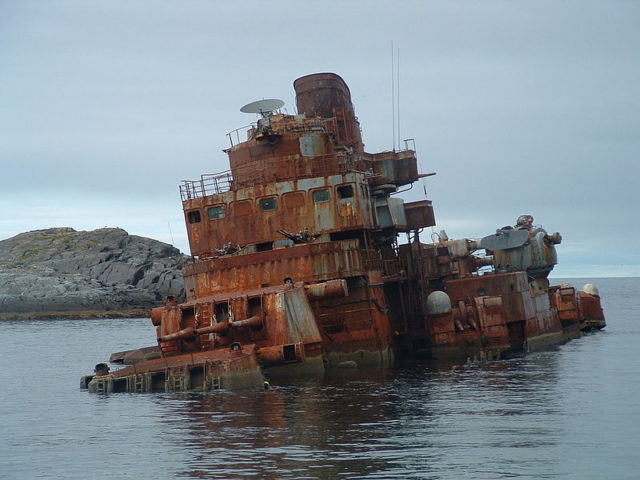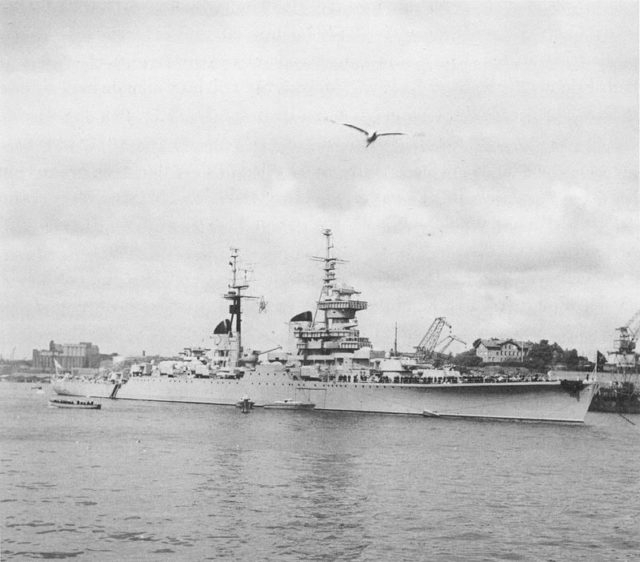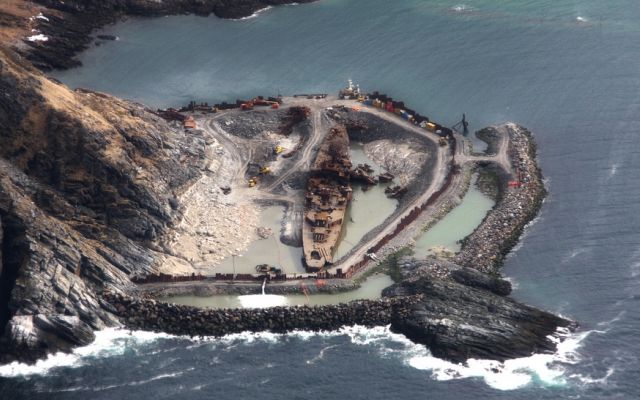The Murmansk was a Russian light cruiser of the Sverdlov-class – Project 68bis of the Soviet Navy’s Northern Fleet. It was once a ship that made the NATO admirals very wary. But, so much for the fear; the Soviet Cruiser Murmansk ended up a naval embarrassment; a corroding old wreck trapped in a Norwegian fjord in the mid-90s.
In many ways, the Murmansk ended up an ideal symbol for the state of the former Soviet military at the time. Now, it’s very easy to forget the real attitude at the time about the Soviet military being an assortment of outdated, useless equipment, as Putin crashes his sword today. It’s also easy to forget that the sanctioning of these ships was a frightening situation for Western naval developers who always seemed to be speculating that the Soviets were on to something otherwise overlooked by other shipbuilders.

Construction began on the Murmansk in 1953 in Severodvinsk and assigned active duty on September 22, 1955. The Murmansk merged with the Russian 2nd Cruiser Division when it was formed in 1956.
In 1994, the Murmansk was sold for scrap to India, but on December 24, 1994, during the transfer, while being towed, the Soviet cruiser broke free, ran aground, and partially sank near the Norwegian village of Sørvær, a small village on an island on the north coast of Norway. An area where the seas are very rough, and the region is often exposed to extreme weather conditions.
At first, it was suggested that the winter storms would destroy sections of the Murmansk that were above the waterline, but in 2009 financing was assigned to pay for the disassembling of the ship. As the vessel was in such poor condition, there was no possibility to tow it. Hence the decision was made to dismantle it piece by piece.
Scandinavia’s largest demolition contractor, AF Decom, built an enormous seawall and dry dock around the Murmansk so the shipwreck could be accessed from land and dismantled where it lay. The water will be drained from the dry dock so that the wreck will be free of water. The construction company will disassemble the cruiser and sort the different demolition materials to be shipped to recycling and waste facilities. The mooring around the wreck was made watertight in April 2012. By mid-May, the dock was almost entirely emptied of water and the dismantling of the vessel commenced. The entire dismantling project was completed in 2013. There is also an ongoing dispute about possible radioactive materials aboard the cruiser. Some people assert that Polonium-210, a highly radioactive metal, which has a half-life of 138 days was found on board.

The Soviets also had plans for several new heavy gunships, including battleships and battle cruisers. Here is where fact and fiction tend to blend as Cold War conspiracy theories mix with deceptions too wild not to be believed. Wondering, as well about the actual validity of these projects or if it was just Stalin merely demonstrating his ego in the name of national security and defense.
Only two significant projects were completed and they were both light cruisers. Project 68 Chapayev was the first. It was the next stage progression of the previous Project 26 Kirov, which was the newest and most advanced cruiser the Soviets had available to face the Nazis in WW II.
Similar to Project 26 Kirov, the Chapayev had strong Italian influences and the most significant difference was the gun size; changing from the Kirov’s 7.1-inch guns to 6-inch guns. It was also declassified from a battle cruiser to a light cruiser in the process. But it did gain an additional turret mount, which provided it with an extra three guns. Project 68bis, of which the Murmansk is included, is an advanced evolution with improved anti-aircraft armament, but still retained the twelve 6-inch gun design.
Their 130 mm auxiliary firepower was state-of-the-art at the time, based on Nazi efforts to knock down American bombers. This armament was perhaps the most advanced, widely utilized anti-aircraft weapons available to the Soviet Navy. As missiles were just coming off the drawing board and into deployment, their primary weaponry still represented pre-WW II “big gun” rationale.

With the dock finally successful in becoming watertight the Murmansk is now exposed enough for work to begin. The pool was not completely drained because the company didn’t want to subject the construction site to unnecessary stress; most of the ship can be easily dismantled as it is situated now.
Here is another story from us: Project Azoria – recovery of the sunken Soviet submarine K-129
The wreck is in extremely poor condition since waves and extreme weather has eroded it for more than 20 years. Now that the cruiser is accessible from the outside the contractor can begin the work and dismantle the wreck section by section.
